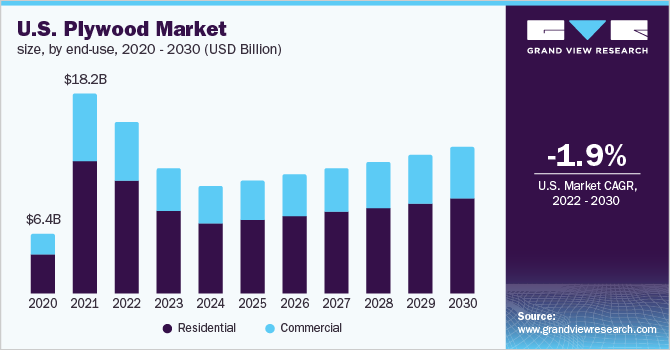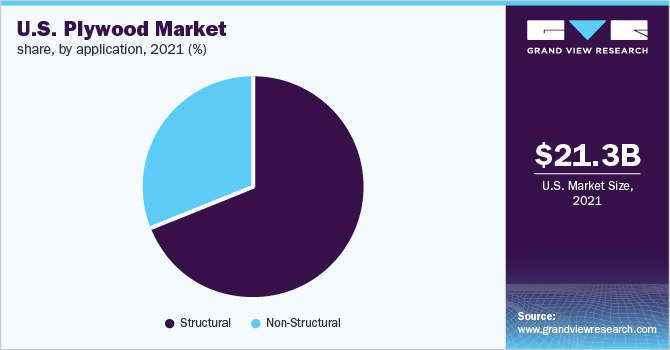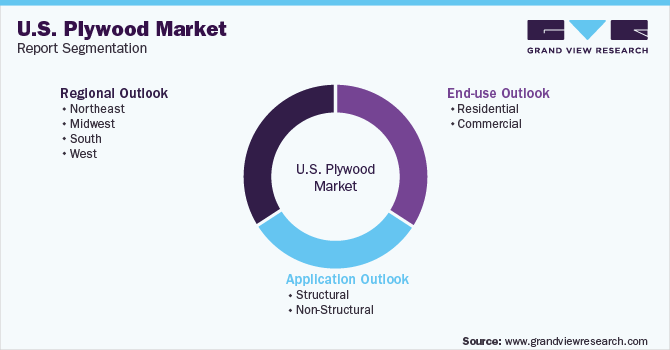- Home
- »
- Advanced Interior Materials
- »
-
U.S. Plywood Market Share & Growth Analysis Report 2030GVR Report cover
![U.S. Plywood Market Size, Share & Trends Report]()
U.S. Plywood Market Size, Share & Trends Analysis Report By End-use (Residential, Commercial), By Application (Structural, Non-Structural), By Region, And Segment Forecasts, 2022 - 2030
- Report ID: GVR-4-68039-995-2
- Number of Report Pages: 108
- Format: PDF, Horizon Databook
- Historical Range: 2017 - 2020
- Forecast Period: 2022 - 2030
- Industry: Advanced Materials
Report Overview
The U.S. plywood market size was estimated at USD 21.30 billion in 2021 and is expected to expand at a compound annual growth rate (CAGR) of -1.9% from 2022 to 2030. The growth is attributed to rising refurbishment activities and growing investments in infrastructural development. The increase in construction and development activities owing to increasing demand for commercial infrastructures such as offices, complexes, institutions, and industries is contributing to the growth of the plywood industry. In addition, with the growing population, the demand for medical & health centers, grocery & retail stores, and entertainment centers such as stadiums, theaters, and museums has increased tremendously.

With the increasing disposable income and growing demand for tourism, the construction of restaurants and hotels & resorts has also experienced considerable growth. This is also responsible for the growth of the plywood market in the U.S. Furthermore, industrial construction activities such as factories, warehouses, and plants are also on the rise due to the increasing volume of international trade and growing demand for industrial goods.
Growth in the organized retail segment, including super-market, hyper-markets, and departmental stores, also contributed to the growth of commercial buildings. Moreover, such building projects also help promote trade for major raw materials including plywood and help promote economic growth.
The government has also launched many construction projects to contribute to industrial development. For instance, on 31 March 2021, the U.S. government revealed its plan to improve the national infrastructure with an investment of USD 2.0 trillion. This plan included nuclear plants, rail projects, and power plants to promote further economic growth. This is further expected to drive the demand for plywood in the U.S.
Additionally, a large number of processes are involved in treating this waste and making it free of chemical toxins. This is negatively impacting the growth of the plywood segment and is promoting the adaption of green buildings. However, with the introduction of green building alternatives, the waste generated can be effectively controlled.
A majority of plywood used in the U.S. market is imported from Indonesia, Canada, Vietnam, and China. From 2020 to 2021, the values of plywood imports went up by over 70% from USD 252 million to USD 430 million. The U.S. Commerce Department levies fines and tariffs against countries like China and Canada, which affects the construction industry.
Additionally, the ongoing trade war between U.S. and China is a threat to the imports of plywood & other wood products. In 2017, US Commerce Department implemented counter-duties on Chinese producers, as China was dumping hardwood plywood products on the U.S. market. In 2018, the administration imposed 25% tariffs on a total of USD 50 billion worth of Chinese goods, including wood doors, with an additional 10% & 25% tariff in 2018 and 2019, respectively.
End-use Insights
The residential segment accounted for the largest revenue share of 66.2% in 2021. The residential segment comprises single-family homes, multi-family residential buildings, apartment houses, and community-based residential facilities. It includes homeowners that construct buildings across the U.S.
The installation of plywood products in residential buildings positively impacts utility costs as plywood offers high strength, impact resistance, and high moisture resistance, which makes it low maintenance and durable. The pandemic has forced many house owners to stay indoors, which, in turn, led to a rise in the demand for the replacement of house components such as ceilings, floors, furniture, cabinets, windows, and sliding. This is expected to have a positive impact on the U.S. plywood industry.
The rising demand for products such as ceilings, outside decks, floorings, bathrooms, and kitchens, which are aesthetically sound, economically feasible, and environmentally friendly is expected to continue to boost the use of plywood products in households in the U.S. Rising disposable income of homeowners has supported this shift toward the beautification of residences in recent times and is expected to help the U.S. plywood market growth over the forecast period.
Commercial buildings comprise education, healthcare, manufacturing, lodging, offices, religious construction, and conservation & development. It includes general contractors, design-build companies, and project managers altogether constructing buildings across the U.S. Plywood products are majorly used in commercial buildings as they are easily cut, lightweight, dimensionally strong, and offer moisture-resistance characteristics.
Application Insights
The structural segment led the market and accounted for the largest revenue share of 68.6% in 2021. Structural plywood offers veneers tested for stiffness and strength, which makes it ideal for commercial and industrial end-use. Structural plywood is majorly used for sheathing, bracing for roofs and floors, storage decks, hoardings, packing crates, outdoor furniture, and playing equipment.

Structural plywood is majorly used for both interior and exterior cladding, such as in residential homes, where it uses A-bond or B-bond adhesives. A-bond adhesive is made from phenol formaldehyde resin whereas B-bond is made from melamine-urea-formaldehyde resin. The natural strength of structural plywood makes it ideal for bracing, which is used for designing and shaping windows. Furthermore, they can be used as flooring for agricultural and sports complexes.
The non-structural plywood is used for decorative applications owing to its smoother and fine finish with few blemishes and knotholes. It is lighter and cheaper compared to structural ones, allowing it to be used as visually beautiful pieces. However, non-structural ones are not ideal for exterior structures as it offers no load-bearing capacity.
The U.S. furniture manufacturing industry is one of the major markets for hardwood. Based on application, the furniture segment dominated the market in 2021 in terms of revenue with a share of 40.6%. The furniture segment includes beds, wardrobes, makeup tables, working desks, sofa sets, dining tables, chairs, and tables.
Plywood offers high strength and resists splitting & warping, which makes it ideal for the production of furniture. The material used to produce furniture is hardwood plywood, such as teak wood, with varied thicknesses and grades. The outer coating of the furniture can be made of veneer, tacon sheet, teak wood profile, and other complementary materials, which makes it more durable and lightweight. It is also structurally strong compared to natural wood and offers higher screw-holding features.
Regional Insights
The Southern region accounted for the largest revenue share of 53.3% in 2021. The Southern U.S. is expected to remain the largest regional industry and witness the fastest growth over the forecast period due to the increasing demand for plywood, which is attributed to the increasing construction activities. The southern U.S. region is expected to grow at a rate of 5.2% in terms of volume over the forecast period.
The South region of the U.S. consists of 14 states including Texas, Virginia, Alabama, Florida, Georgia, Louisiana, and North & South Carolina. The presence of major manufacturers in the region exhibits strong competition among players in the market. For instance, Georgia Pacific, Colombia Forest Products, RoyOMartin, and BlueLinx are all based in the southern part of the U.S. According to World Population Review, the South consists of states with most forestland in the U.S., which is used for producing plywood.
Big economies such as Texas, Virginia, Florida, and Georgia are witnessing an increase in population along with a high standard of living, which is expected to boost plywood demand. Construction is one of the biggest sectors in Texas and is expected to move forward over the forecast period.
The West region is expected to grow at a rate of 4.7% over the forecast period. The increasing demand for wood products, such as residential and commercial plywood products, from various end-use industries is expected to boost the market demand in the U.S. The west region of the U.S. consists of states including Alaska, California, Washington, Oregon, Idaho, New Mexico, and Utah.
Key Companies & Market Share Insights
The market is characterized by strong competition owing to the large and established players in the U.S. market. Prominent players operating in the U.S. region include Georgia Pacific, PotlatchDeltic Corporation, Weyerhaeuser Company Ltd., Boise Cascade Company, and Roseburg Forest Products.
These players are engaged in the manufacturing and distribution of hardwood and softwood plywood in form of wall sheathing, siding, sturd-I-floor, panels, sanded, and more. The manufacturers in the U.S. cater to the demand from construction & buildings, furniture, cabinets, ceilings, flooring, and light frame applications from the commercial and residential industry. Some prominent players in the U.S. plywood market include:
-
Georgia Pacific
-
PotlatchDeltic Corporation
-
Weyerhaeuser Company Ltd.
-
Boise Cascade Company
-
Roseburg Forest Products
-
West Fraser
-
Columbia Forest Products
-
RoyOMartin
-
Timber Products Company
-
Coastal
-
Hood Industry
-
BlueLinx
-
South Coast Lumber Co. & Affiliates
U.S. Plywood Market Report Scope
Report Attribute
Details
Market size value in 2022
USD 18.24 billion
Revenue forecast in 2030
USD 15.59 billion
Growth rate
CAGR of -1.9% from 2022 to 2030
Base year for estimation
2021
Actual estimates/Historical data
2017 - 2020
Forecast period
2022 - 2030
Quantitative units
Revenue in USD million, volume in thousand cubic meters, and CAGR from 2021 to 2030
Report coverage
Revenue forecast, volume forecast, growth factors, and trends
Segments covered
End-use, application, region
Regional scope
South; West; Midwest; Northeast
Country scope
U.S.
Key companies profiled
Georgia Pacific; PotlatchDeltic Corporation; Weyerhaeuser Company Ltd.; Boise Cascade Company; Roseburg Forest Products; West Fraser; Columbia Forest Products; RoyOMartin; Timber Products Company; Coastal; Hood Industry; BlueLinx; South Coast Lumber Co. & Affiliates
Customization scope
Free report customization (equivalent up to 8 analysts working days) with purchase. Addition or alteration to country, regional & segment scope.
Pricing and purchase options
Avail customized purchase options to meet your exact research needs. Explore purchase options
U.S. Plywood Market Segmentation
This report forecasts the volume and revenue growth at the country level and provides an analysis of the latest industry trends in each of the sub-segments from 2017 to 2030. For this study, Grand View Research has segmented the U.S. plywood market report based on end-use, application, and region:

-
End-use Outlook (Volume, Thousand Cubic Meters; Revenue, USD Million, 2017 - 2030)
-
Residential
-
Commercial
-
-
Application Outlook (Volume, Thousand Cubic Meters; Revenue, USD Million, 2017 - 2030)
-
Structural
-
Non-Structural
-
Furniture
-
Kitchen Cabinet
-
Flooring
-
Container Floor
-
Others
-
-
-
Regional Outlook (Volume, Thousand Cubic Meters; Revenue, USD Million, 2017 - 2030)
-
Northeast
-
Midwest
-
South
-
West
-
Frequently Asked Questions About This Report
b. The U.S. plywood market size was estimated at USD 21.30 billion in 2021 and is expected to reach USD 18.24 billion in 2022.
b. The U.S. plywood market is expected to grow at a compound annual growth rate of -1.9% from 2022 to 2030 to reach USD 15.59 billion by 2030.
b. The residential segment dominated the U.S. plywood market with a market share of 66.2% in 2021. This is accounted to the increased spending in interior modifications along with the growing construction segment.
b. Some of the key players operating in the U.S. plywood market include Georgia Pacific, PotlatchDeltic Corporation, Weyerhaeuser Company Ltd., Boise Cascade Company, Roseburg Forest Products, West Fraser, Columbia Forest Products, RoyOMartin, Timber Products Company, Coastal, Hood Industry, BlueLinx, South Coast Lumber Co. & Affiliates
b. The key factors driving the growth of U.S. plywood market include growing investments in the construction sector and infrastructural development across the U.S.
Share this report with your colleague or friend.
![gvr icn]()
NEED A CUSTOM REPORT?
We can customize every report - free of charge - including purchasing stand-alone sections or country-level reports, as well as offer affordable discounts for start-ups & universities. Contact us now
![Certified Icon]()
We are GDPR and CCPA compliant! Your transaction & personal information is safe and secure. For more details, please read our privacy policy.
We are committed towards customer satisfaction, and quality service.
"The quality of research they have done for us has been excellent."





